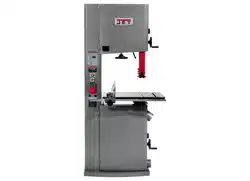Loading ...
Loading ...
Loading ...

23
• the "set" of the teeth
• the blade material itself.
11.1 Width
Band saw blades come in different standard widths,
measured from the back of the blade to the tip of the
tooth. Generally, wider blades are used for ripping
or making straight cuts; narrower blades are often
used when the part being cut has curves with small
radii. When cutting straight lines with a narrow
blade, the blade may have a tendency to wander,
causing blade lead.
The thinner the blade, the tighter will be the
minimum radius of cut. Always use widest blade
possible for the job.
General rules for blade selection:
• Select coarser pitch blades for thicker or softer
material.
• Select finer pitch blades for thinner or harder
material.
• Use fine pitch blades to obtain a smooth finish.
• Use coarse pitch blades to obtain faster cutting
speeds (thick material).
• To prevent premature blade wear, use fastest
practical speed.
• Adjust feed rate to ensure continuous cutting
action.
• Run the bandsaw with blade centered in upper
and lower guides, and guide fingers adjusted as
close as possible without touching the blade or
weld joint. Never adjust guide fingers while
blade is running. Failure to comply may cause
serious injury.
11.2 Pitch
Pitch is measured in "teeth per inch" (TPI). Figure
11-1 shows blades with different pitches. A fine pitch
(more teeth per inch) will cut more slowly but
smoother. A coarse pitch (fewer teeth per inch) will
cut rougher but faster. As a rule of thumb, the thicker
the workpiece, the coarser will be the blade pitch. If
you have to cut a hard or very brittle material, you
will probably want to use a blade with a finer pitch in
order to get good clean cuts.
General rule: Use a blade that will have no fewer
than 6 and no more than 12 teeth in the workpiece
at any given time.
Figure 11-1
11.3 Shape
Figure 11-2 shows common types of tooth shape.
Tooth shape has an effect on cutting rate, and with
few exceptions, the Skip and Hook types are used
to obtain higher feed rates when cutting thick
workpieces. Variable-tooth blades are also
available, which combine features of the other
styles.
Figure 11-2
Note: When cutting thin materials, the rule for blade
pitch is to have a minimum of two teeth engaging
the material being cut at all times.
Standard Tooth – generally used to cut ferrous
metals, hard bronze, hard brass, and thin metals.
Skip Tooth – have better chip clearance (larger
gullet) and are used on softer, non-ferrous materials
such as aluminum, copper, magnesium, and soft
brass.
Hook Tooth – provides a chip breaker and has less
tendency to gum up in softer materials. Used in the
same materials as skip tooth but can be fed faster
than standard or skip tooth blades.
11.4 Set
The term "set" refers to the way in which the saw
teeth are bent or positioned. Set patterns are usually
selected depending on the type of material that
needs to be cut. Three common set patterns are
shown in Figure 11-3.
Generally:
Loading ...
Loading ...
Loading ...
